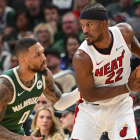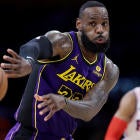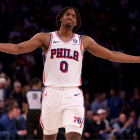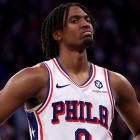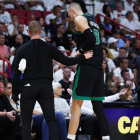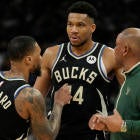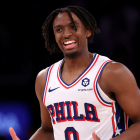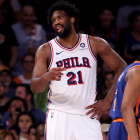Anything that’s worth doing is worth doing twice as big. That may not be a famous saying, but we here at CBS Sports believe it at our essence. Accordingly, here’s an updated list of NBA Draft prospects, only taking individual talent/potential into consideration -- in contrast to our mock draft, which incorporates team needs. And instead of 30 like last time, we’re going 60 strong for you. Let all the prospecting wash over you.
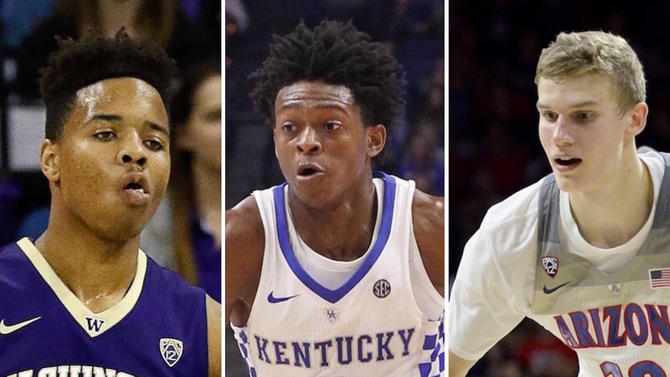
Top 60 NBA Draft Prospects
1. Markelle Fultz, Washington: He’s been pretty much the consensus No. 1 pick all year. He’s a dynamic playmaker at the point guard position -- a scorer, a shooter, a potentially elite defender, and he’s hitting whatever the opposite of the freshman wall is. Not really a weakness in the bag.
2. Josh Jackson, Kansas: The defense, rebounding and motor were already elite. Now the shot is coming, and everyone needs to take cover. Jackson’s versatile game translates perfectly to the NBA.
3. Lonzo Ball, UCLA: His father thinks he’ll be better than Steph Curry, which might be a stretch -- but the fact that we can’t call it completely ridiculous shows you Ball’s upside. He’s a floor general in the mold of a Jason Kidd who can shoot the lights out from deep despite the funkiest of deliveries.
4. Jonathan Isaac, Florida State: His consistency has dipped in February, but still shows the ability to be a plus stretch-four on both ends most nights. He’s crazy athletic, can block shots and handles the ball well without turning it over.
5. Lauri Markkanen, Arizona: A tough stretch lately, but still a legit 7-footer shooting better than 47 percent from three. In today’s NBA, a big man with Markkanen’s skill is always highly sought after.
6. Dennis Smith, North Carolina State: Rumors were swirling about the dismissal of his coach (which was announced Thursday), North Carolina’s defense was swarming, and still Smith put up 27 points Wednesday night. He doesn’t always bring is A-game, and the consistency is an issue, but when he does he’s as good as anyone in the draft.
7. Malik Monk, Kentucky: The definition of what a two-guard needs to be in the current NBA. Perhaps he won’t bring much besides his shot and elite athleticism to the NBA level, but that’s enough to make a major impact. Players like Zach LaVine have proven that if you’re a freak athlete who can shoot, you can be successful right away in the NBA.
8. Robert Williams, Texas A&M: Three straight games with 18 points, including a pair of double-doubles, suggests the offense is catching up to the defense, which has to have NBA scouts smiling. At 6-9 with great length, Williams can fit into almost any roster right away.
9. De’Aaron Fox, Kentucky: The defensive stopper at the point you’re going to need, especially once the guys on this list arrive in the NBA. He’s a fast as John Wall in the open court -- maybe faster -- but the jumper needs work.
10. Frank Ntilikina, France: More than a lottery ticket, if less than a sure thing in this particular draft. If he gets put into the right situation and continues to develop, Ntilikina could be a franchise-changing player.
11. Justin Patton, Creighton: Asked to take on more of the offensive load, the 6-11 big man shows now sign of slowing down his elite efficiency.
12. Jayson Tatum, Duke: Now the perimeter shot looks smoother, and the defensive presence makes him a legit rim protector as well. Tatum has the skills to be an elite scorer in the NBA, and a big March could vault him into the top half of the lottery.
13. Johnathan Motley, Baylor: Unstoppable on offense. It’s worth ignoring that it took until his junior year to reach this point because he’s here now, and we’ve seen how maturity can lead to immediate success in the NBA.
14. Justin Jackson, North Carolina: The difference between Jackson of North Carolina and Jackson of Kansas is far smaller than many believe. The 6-8 junior has improved every season at UNC and has developed into a close to 40 percent shooter from 3-point range.
15. Josh Hart, Villanova: The best player on the best team in college basketball once again, apologies to Gonzaga. He knows how to score, and his assists have nearly doubled in his senior season -- he’ll be ready to play right away.
16. Allonzo Trier, Arizona: Tough game against Cal followed a bravura performance that included 12-of-12 from the line against Stanford. What could have been a breakout sophomore year has been slowed by injury, but there’s no doubt that the talent is there.
17. Frank Mason, Kansas: Got to the line 18 times against burly West Virginia, and sank 16 of them. If there was ever time to believe in a diminutive point guard who knows how to score and get to the line, it’s now.
18. Isaiah Hartenstein, Germany: Increasingly, the kind of center teams don’t just want, but need. The 18-year-old 7-footer already has an NBA frame and quickness for his size.
19. Caleb Swanigan, Purdue: The Boilermakers are a top-21 team in efficiency at both ends, and Swanigan is by far the biggest reason why. He’ll be able to inhale rebounds in the NBA right away.
20. T.J. Leaf, UCLA: A 6-10 stretch-four who can sink the three, but doesn’t live by it — nearly 80 percent of his shots come inside the arc, and he shoots 66.4 percent from two.
21. Ivan Rabb, California: Games like his four-point no-show against Arizona are all that stand between Rabb and a much higher spot on this list. The talent is there, but consistency is a huge question mark.
22. Miles Bridges, Michigan State: Increasingly convinced he’s not just a tweener, but will hold his own at both the three and the four.
23. Tacko Fall, Central Florida: No one has figured out how to stop him or get around the 7-foot-6 sophomore yet. As his conditioning improves, he could become a defensive monster at the NBA level.
24. Thomas Bryant, Indiana: Already extremely efficient in both the halfcourt and transition games, he’s a strong finisher with long range. The 6-10 center hasn’t made a huge jump in his sophomore season, but you couldn’t ask for more consistency.
25. Tyler Lydon, Syracuse: Easiest way to think of Lydon is that he’s what the Magic hoped Aaron Gordon would be for them. The 6-8 forward is shooting 42 percent on 3s.
26. Ethan Happ, Wisconsin: Recent dip in scoring form likely to be temporary, and didn’t stop doing everything else when it happened. He hasn’t attempted a 3-pointer this season, so definitely not going to stretch the floor.
27. Zach Collins, Gonzaga: No way is Gonzaga undefeated without this automatic mismatch in every game. The 7-footer would be a worthwhile selection in the late first round.
28. Mikal Bridges, Villanova: Steady, efficient and deadly -- a microcosm of his Wildcats. He has great size from the wing and is a 40 percent 3-point shooter.
29. Alec Peters, Valparaiso: Remember: the Horizon League can’t stop him, but neither could Oregon or Kentucky. You don’t average 23 points and 10 rebounds without some serious skill.
30. Harry Giles, Duke: Giles was the top player in his class coming out of high school before the injuries hit. He’s shown some flashes of late, so he remains here, but he’s really just parked until we figure out what part of the post-injuries decline is permanent.

31. John Collins, Wake Forest: A near-perfect game against Clemson marked nine straight contests with at least 20 points.
32. Terrance Ferguson, Australia: Has that hybrid SG-SF height already, and the shot looks sweet as well.
33. Luke Kennard, Duke: Impossible to ignore the way he’s stood out as Duke’s best player for much of the year — through 3s and getting to the hoop. That’ll play.
34. Jaron Blossomgame, Clemson: Somebody’s going to need to guard all these versatile wings, and he may be the one to do it.
35. Marcus Marshall, Nevada: Has a chance to help a team at the one or the two, with athleticism seldom found in a grad transfer.
36. Chimeze Metu, USC: A rim protector the day he arrives in a league, and improving post game suggests more to come.
37. P.J. Dozier, South Carolina: The kind of combo guard who collects minutes in NBA rotations.
38. Tony Bradley, North Carolina: Come for the way he runs the break, stay for the soft hands.
39. Dillon Brooks, Oregon: A game-changing wing when he’s healthy.
40. Matthias Lessort, Martinique: Finally getting a chance to prove he’s a stretch-five who can produce, and taking advantage of the opportunity -- extremely efficient for the French league, particularly for his age.
41. Devonte Graham, Kansas: Only on the Jayhawks, and select few other programs, would he be the backup point guard.
42. Grayson Allen, Duke: Not a real point guard, but the uptick in accuracy of late provides more optimism he can be a designated shooter off the bench.
43. Monte Morris, Iowa State: My favorite part of Morris’ game, a kind of starter house point guard at the NBA level, is that he simply never turns the ball over.
44. Dwayne Bacon, Florida State: Probably a two-guard at the next level, and older than his two years at Florida State suggests, but finding consistency from three just in time.
45. Semi Ojeleye, SMU: The lone time he failed to score in double-digits this year, he still put up nine points. Plays virtually every minute for an SMU team that badly needs him.
46. Kobi Simmons, Arizona: Has everything you could ever want in a point guard, just needs to convert those tools to skills, and has time to do it.
47. Nigel Hayes, Wisconsin: Tough enough and smart enough to carve out a role at the next level.
48. Isaiah Briscoe, Kentucky: Still unclear the path he’ll take to an NBA roster spot, but he has several options, from point guard to defense-first two.
49. L.J. Peak, Georgetown: Don’t let the 6-foot-5 fool you, he’s every bit strong enough to play the three, and finds ways to get his own shot -- and to the basket -- in traffic. The guy you want with the ball late in games.
50. Joel Berry, North Carolina: The maestro of that North Carolina offense played at NBA speed.
51. Melo Trimble, Maryland: Kept his efficiency steady while becoming Maryland’s main source of offense, and scouts noticed.
52. Jessie Govan, Georgetown: A stretch five with a Georgetown defensive pedigree is going to be worth a look.
53. Bryce Alford, UCLA: Makes teams pay whenever given even a bit of shooting space.
54. Angel Delgado, Seton Hall: That post game and elite rebounding should etch Delgado into someone’s rotation.
55. Cameron Johnson, Pittsburgh: few are more consistent at both getting to the rim and making those who sag off pay from deep.
56. Jordan Bell, Oregon: Continues to look like that rim-protecting four so many teams need, though the foot injury history is of concern.
57. D.J. Hogg, Texas A&M: The three isn’t where it needs to be yet, but Hogg’s elite passing for his size (22.3 percent assist percentage this year) gets him on the list.
58. Marques Bolden, Duke: It’s been a lost year for Bolden, but Coach K doesn’t recruit guys for no reason.
59. Jawun Evans, Oklahoma State: Brad Underwood has his floor maestro, and Evans has time to add even more to the unexpected surprise breakout of the Big 12 conference.
60. Wesley Iwundu, Kansas State: Athletic prototype three whose scoring is consistent now, and rebounds especially well for the position.














